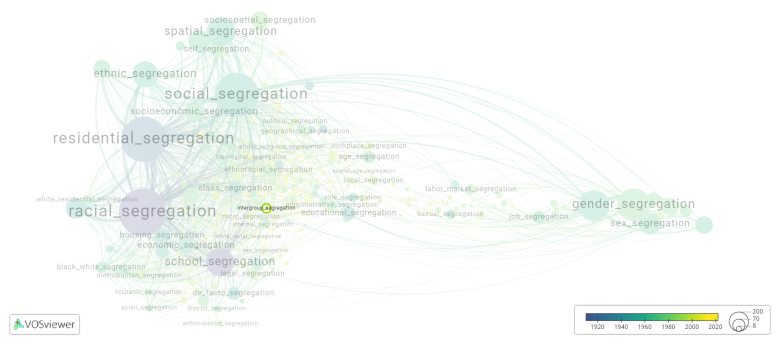Intergroup segregation: Difference between revisions
(Creating page) |
(Creating page) |
||
| (6 intermediate revisions by the same user not shown) | |||
| Line 15: | Line 15: | ||
Intergroup segregation is frequently discussed in the literature with the following segregation forms: | Intergroup segregation is frequently discussed in the literature with the following segregation forms: | ||
[[residential segregation]], [[white residential segregation]], [[latino white segregation]] | |||
[[intergroup_segregation.png|780x780px]] | [[File:intergroup_segregation.png|780x780px]] | ||
For the complete network of | |||
This visualization is based on the study [[Segregation_Wiki:About| The Multidisciplinary Landscape of Segregation Research]]. | |||
year of publication https://tinyurl.com/ | |||
For the complete network of interrelated segregation forms, please refer to: | |||
* [https://tinyurl.com/2235lkhw First year of publication] | |||
* [https://tinyurl.com/2d8wg5n3 Louvain clusters] | |||
* [https://tinyurl.com/223udk5r Betweenness centrality] | |||
* [https://tinyurl.com/244d8unz Disciplines in which segregation forms first emerged (Scopus database).] | |||
==References== | ==References== | ||
==Notes== | ==Notes== | ||
Latest revision as of 07:17, 16 October 2024
Date and country of first publication[1][edit | edit source]
2007
United States
Definition[edit | edit source]
Intergroup segregation refers to the separation of different social, ethnic, or cultural groups within a society. It can occur in various contexts, such as residential areas, schools, workplaces, or even public spaces.
Intergroup segregation often arises due to historical, socioeconomic, and cultural factors that contribute to the creation of distinct communities. This separation can be voluntary or enforced by laws, policies, or systemic discrimination.
This phenomenon can have significant social, economic, and psychological consequences. It can perpetuate inequality and disadvantage for marginalized groups, limit opportunities for interactions and understanding between different groups, and perpetuate stereotypes and biases.
Efforts to address intergroup segregation involve promoting diversity, inclusion, and equal opportunities. These may include policies such as desegregation programs, promoting affordable housing in diverse neighborhoods, implementing anti-discrimination laws, and fostering intergroup contact and dialogue.
See also[edit | edit source]
Related segregation forms[edit | edit source]
Intergroup segregation is frequently discussed in the literature with the following segregation forms:
residential segregation, white residential segregation, latino white segregation

This visualization is based on the study The Multidisciplinary Landscape of Segregation Research.
For the complete network of interrelated segregation forms, please refer to:
References[edit | edit source]
Notes[edit | edit source]
- ↑ Date and country of first publication as informed by the Scopus database (December 2023).
At its current state, this definition has been generated by a Large Language Model (LLM) so far without review by an independent researcher or a member of the curating team of segregation experts that keep the Segregation Wiki online. While we strive for accuracy, we cannot guarantee its reliability, completeness and timeliness. Please use this content with caution and verify information as needed. Also, feel free to improve on the definition as you see fit, including the use of references and other informational resources. We value your input in enhancing the quality and accuracy of the definitions of segregation forms collectively offered in the Segregation Wiki ©.
Intergroup segregation appears in the following literature[edit | edit source]
Wahl A.-M.G., Breckenridge R.S., Gunkel S.E. (2007). Latinos, residential segregation and spatial assimilation in micropolitan areas: Exploring the American dilemma on a new frontier. Social Science Research, 36(3), 995-1020. https://doi.org/10.1016/j.ssresearch.2006.07.004
